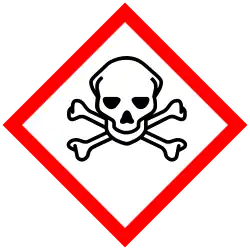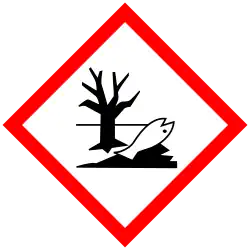Esprocarb
 | |
| Names | |
|---|---|
| Preferred IUPAC name
S-benzyl ethyl[(2Ξ)-3-methylbutan-2-yl]carbamothioate | |
Other names
| |
| Identifiers | |
3D model (JSmol)
|
|
| ChEBI | |
| ChEMBL | |
| ChemSpider | |
| ECHA InfoCard | 100.111.286 |
| EC Number |
|
| KEGG | |
PubChem CID
|
|
| UNII | |
CompTox Dashboard (EPA)
|
|
| |
| Properties | |
| C15H23NOS | |
| Molar mass | 265.42 g·mol−1 |
| Appearance | Yellowish liquid[2] |
| Odor | Odourless[2] |
| Density | 1.035 g/mL[2] |
| Melting point | 25 °C (77 °F; 298 K) [3] |
| Boiling point | 135 °C (275 °F; 408 K) [2] |
| 0.0049 g/L[2] | |
| Vapor pressure | 10.1 mPa[3] |
| Hazards[2] | |
| GHS labelling: | |
 
| |
| Danger | |
| H315, H319, H331, H411 | |
| P261, P280, P305+P351+P338, P321, P405, P501 | |
| Lethal dose or concentration (LD, LC): | |
LD50 (median dose)
|
|
LC50 (median concentration)
|
>4 mg/L (mammal, inhalation, 4 hours)[2] |
Except where otherwise noted, data are given for materials in their standard state (at 25 °C [77 °F], 100 kPa).
Infobox references
| |
Esprocarb is a thiocarbamate herbicide[1] used preёmergently and post emergently to control annual weeds and grasses, such as on paddy rice. It was introduced in 1988 in Japan[3]
Esprocarb mixes have been tested in Japan starting in 1985 for its effectiveness against cockspur grass (Echinochloa crus-galli), often mixed with the herbicide bensulfuron-methyl. Testing for esprocarb was meant to allow for a longer, residual control of weeds, eliminating the need for follow-up one-shot herbicide applications.[4]
Esprocarb's mode of action makes its HRAC classification Group K3 (global), Group K (Aus), Group 15 (numeric); it inhibits very long chain fatty acid synthesis.[3]
It is usually sold as granules and has been marketed as "Fuji-Grass".[3]
Environmental behavior
Esprocarb is toxic to fish; its 96-hour LC50 for fish is 1.52 g/L.[2] It is not toxic to birds or mammals, with an LD50 over 2000 mg/kg.[3] It has a GHS 'Toxic' mark,[2] though its low toxicity should exempt it.
It is non-mobile in soil and has a soil half-life of 50 days, making it moderately persistent.[3]
References
- ^ a b c d "esprocarb data sheet". www.bcpcpesticidecompendium.org.
- ^ a b c d e f g h i j "Esprocarb | Safety data sheet according to 1907/2006/EC, Article 31". www.lgcstandards.com. LGC Standards. 15 January 2021. Retrieved 20 July 2025.
- ^ a b c d e f g Lewis, Kathleen A.; Tzilivakis, John; Warner, Douglas J.; Green, Andrew (18 May 2016). "An international database for pesticide risk assessments and management". Human and Ecological Risk Assessment: An International Journal. 22 (4): 1050–1064. Bibcode:2016HERA...22.1050L. doi:10.1080/10807039.2015.1133242. hdl:2299/17565.
- ^ Kadota, G; Matsumoto, S; Nakamura, S; Gordon, R F S; Hayakawa, J (1990). "Esprocarb Herbicide Mixtures: Use in Japanese Paddy Rice". Pest Management in Rice: 389–401. doi:10.1007/978-94-009-0775-1_32. ISBN 978-94-010-6835-2.
External links
- Esprocarb in the Pesticide Properties DataBase (PPDB)